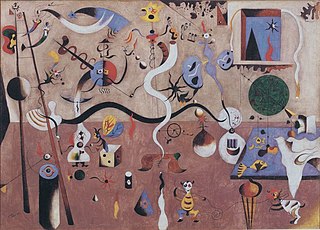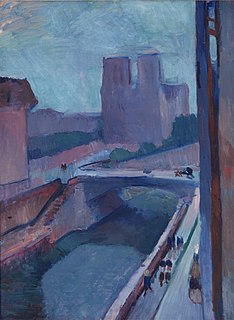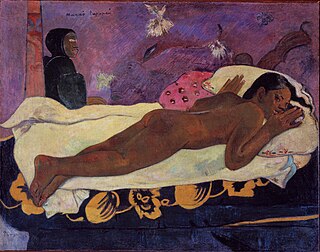 W
WDanseuse au café is a large oil painting created in 1912 by the French artist and theorist Jean Metzinger (1883–1956). The work was exhibited in Paris at the Salon d'Automne of 1912, entitled Danseuse. The Cubist contribution to the 1912 Salon d'Automne created a controversy in the Municipal Council of Paris, leading to a debate in the Chambre des Députés about the use of public funds to provide the venue for such 'barbaric' art. The Cubists were defended by the Socialist deputy, Marcel Sembat. This painting was realized as Albert Gleizes and Jean Metzinger, in preparation for the Salon de la Section d'Or, published a major defence of Cubism, resulting in the first theoretical essay on the new movement, Du "Cubisme". Danseuse au café was first reproduced in a photograph published in an article entitled Au Salon d'Automne "Les Indépendants" in the French newspaper Excelsior, 2 Octobre 1912. The painting is now located at the Albright-Knox Art Gallery, Buffalo New York.
 W
WDynamism of a Dog on a Leash, sometimes called Dog on a Leash or Leash in Motion, is a 1912 painting by Italian Futurist painter Giacomo Balla. It was influenced by the artist's fascination with chronophotographic studies of animals in motion. It is considered one of his best-known works, and one of the most important works in Futurism, though it received mixed critical reviews. The painting has been in the collection of the Albright–Knox Art Gallery since 1984.
 W
WThe Harlequin's Carnival is an oil painting rendered by Joan Miró between 1924 and 1925. It is one of the most outstanding surrealist paintings of the artist, and it is preserved in the Albright–Knox Art Gallery, Buffalo.
 W
WThe Lady's Last Stake, originally entitled Piquet: or Virtue in Danger, is a painting by William Hogarth, c.1759. The work is a conversation piece, capturing the moment when the woman has to make a fateful decision: to be ruined financially, or morally. It was one of Hogarth's last works, commissioned by James Caulfeild, 4th Viscount Charlemont, who allowed Hogarth to select the subject and price.
 W
WL'Homme au hamac, also referred to as Man in a Hammock, is a painting created in 1913 by the French artist, theorist and writer Albert Gleizes. The work was exhibited at Moderni Umeni, SVU Mánes, Vystava, Prague, February – March 1914, no. 41; and Der Sturm, Berlin, July – August 1914. The painting was reproduced in Guillaume Apollinaire, Paris-Journal, July 4, 1914 ; and Albert Gleizes, L'Épopée, Le Rouge et le Noir, October 1929, p. 81. Stylistically Gleizes' painting exemplifies the principle of mobile perspective laid out in Du "Cubisme", written by himself and French painter Jean Metzinger. Evidence suggests that the man reclining in the hammock is indeed Jean Metzinger. Formerly in the collection of Metzinger, the first owner of the painting, Man in a Hammock forms part of the permanent collection of the Albright-Knox Art Gallery, Buffalo, New York.
 W
WNotre-Dame, une fin d'après-midi is a painting by Henri Matisse from 1902. Its somber coloration is typical of Matisse's works executed between the end of 1901 and the end of 1903, a period of personal difficulties for the artist. This episode has been called Matisse's Dark Period.
 W
WPortrait of Seymour H. Knox is a 1985 portrait by Andy Warhol of Seymour H. Knox II. It was donated by the families of his two sons, Mr. and Mrs. Seymour H. Knox III and Mrs. and Mrs. Northrup R. Knox, to the Albright-Knox Art Gallery in honor of Seymour H. Knox II for his 60-year contribution as a member of the Buffalo Fine Arts Academy.
 W
WSelf-Portrait with Monkey is an oil on masonite painting by Mexican artist Frida Kahlo, commissioned in 1938 by A. Conger Goodyear, then president of the Museum of Modern Art in New York City. It is one of the many self-portraits painted by Kahlo for friends and patrons during her career.
 W
WSpirit of the Dead Watching is an 1892 oil on burlap canvas painting by Paul Gauguin, depicting a nude Tahitian girl lying on her stomach. An old woman is seated behind her. Gauguin said the title may refer to either the girl imagining the ghost, or the ghost imagining her.
 W
WThe Voice of Space is an oil painting by René Magritte. Four oil versions exist of the image. The most famous is that held in the Solomon R. Guggenheim Foundation, Peggy Guggenheim Collection, Venice. Another publicly displayed version is held at the Albright-Knox Art Gallery, Buffalo, New York.
 W
WThe Yellow Christ is a painting executed by Paul Gauguin in 1889 in Pont-Aven. Together with The Green Christ, it is considered to be one of the key works of Symbolism in painting.
 W
W W
W